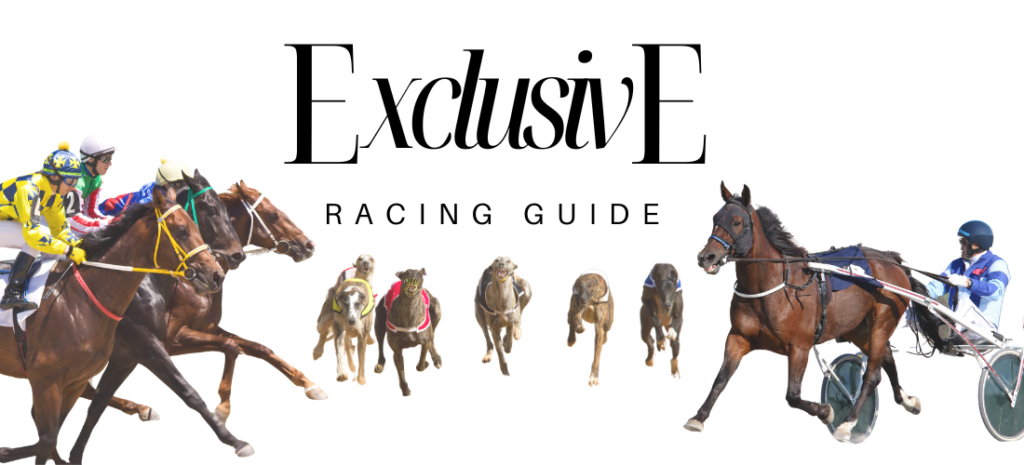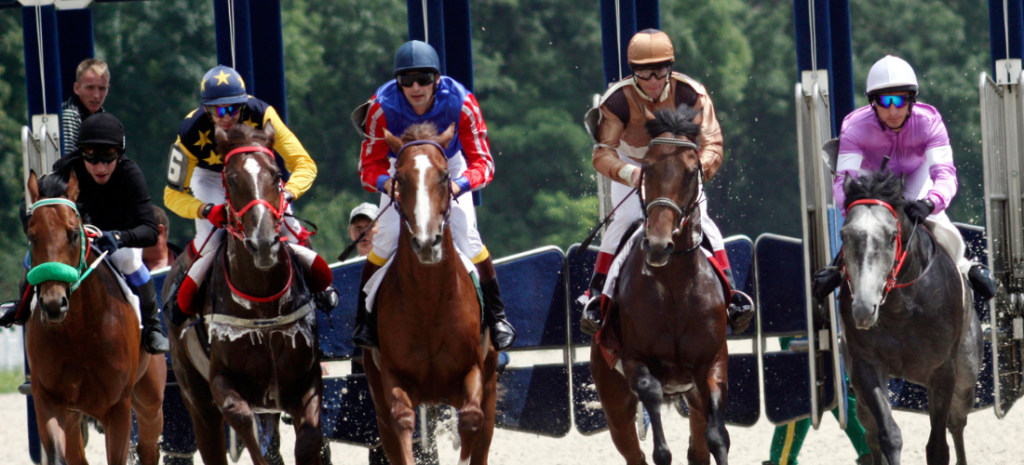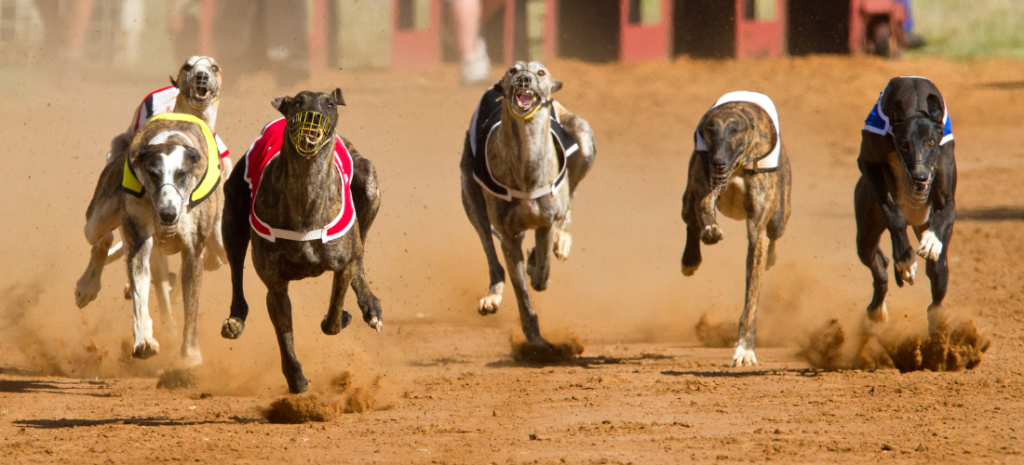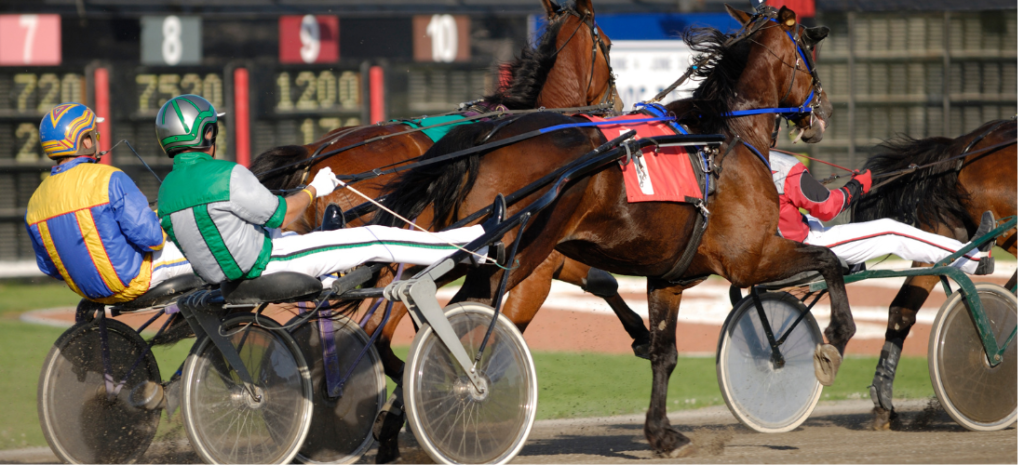
In this article we showcase our Exclusive Racing Guide, delving deep into the World’s Racing Industries of Horse Racing, Grey Hound Racing & Harness Racing. Exploring each individual industry’s history, top tracks worldwide and essential tips to give a valued insight into the world of racing.
Table of Contents
Horse Racing Guide

Immerse yourself in the thrilling world of horse racing, where majestic horses and skilled jockeys battle fiercely for glory! Experience the mystique and history of this beloved sport, adored by equine aficionados and brave betting enthusiasts alike.
Horse racing, the thrilling ‘Sport Of Kings’, gallops through a world of excitement and diversity. From heart-pounding competitions for specific breeds to adrenaline-fueled races over obstacles and varying distances, this highly popular sport captivates audiences worldwide. With races happening almost daily and hundreds of tracks operating globally, it’s a vibrant spectacle that never ceases to amaze. Saddle up, bet, and immerse yourself in a world where hooves thunder and champions are crowned!
Horse Racing History
The sport of horse racing has a long history, beginning with the domestication of horses by nomadic tribesmen in Central Asia. It has been practiced in different settings and by various groups of people over time.
Horse racing has its origins in the 12th Century, when English knights introduced Arab horses from the Crusades and crossed them with English mares to create the Thoroughbred breed. This breed is known for its speed and endurance, leading to private betting among the nobility on Thoroughbred races.
Horse racing events started at Newmarket in 1660 during King Charles II’s reign. In Queen Anne’s rule (1702-1714), horse racing expanded to include multiple horses and betting spectators. This led to the establishment of the professional discipline known as the Sport of Kings. In 1750, the Jockey Club was formed to govern the sport, create rules, sanction racecourses, and name races. The Jockey Club also created the General Stud Book to record the pedigree of all racing Thoroughbreds.
The first racetrack in the United States was established in 1665. During the eighteenth century, racing gained popularity and became more organised with the construction of racecourses, introduction of new horse racing rules, and the achievement of records.
The American Stud Book was implemented in 1868. The American Jockey Club was formed in 1894. Bookmaking was prohibited in the early 1900’s, but horse racing was saved by pari-mutuel betting in 1908. Since then, horse racing world wide has continued to improve and grow.
Racing Guide Top Essential Tips
- Learn & Understanding the Basics
- Understanding the Odds
- Studying Statistics
- Track conditions and weather
- Bankroll Management
- Following The Experts
- Learn More..
Top 10 Horse Races
10. The Everest
The race takes place on the second or third Saturday in October at Randwick Racecourse in Sydney, Australia. The purse for the race is A$15 million (or $11.290 million). The inaugural race was held in 2017.
The Everest, the world’s richest race on turf, began in 2017 and is not yet eligible for Grade 1/Group 1 status. However, the substantial amount of prize money available makes it an event worth noting.
The Everest is a notable race in the Sydney Spring Carnival that has an entry fee and 12 slots in the starting gate, each sold for $600,000. Redzel, a five-year-old gelding, won the race in 2017 and repeated as the winner the next year.
9. Epsom Derby
The race is held on the first Saturday in June at Epsom Downs, Surrey, England. The purse for the race is £1,125,000 (or $1.485 million), and it was first held in 1780.
The Epsom Derby, also known as the Derby Stakes or Cazoo Derby, is the second leg of the English Triple Crown. It is a Group 1 flat race for three-year-old colts and fillies, spanning a distance of 2,420 meters (approximately 1 mile, four furlongs), and taking place at the historic Epsom Downs.
The premier Thoroughbred race in England, which has been held since 1780, is the richest flat race in the UK and attracts approximately 130,000 spectators annually, including British royalty.
8. Melbourne Cup
The Melbourne Cup takes place on the first Tuesday in November at Flemington Racecourse in Melbourne, Australia. The prize money for the race is A$8 million (or $6.021 million), and it was initially held in 1861.
The annual Melbourne Cup is a well-known Thoroughbred race in Australia, which is called “the race that stops a nation.” It is a 3,200-meter turf handicap for three-year-olds and older horses and is considered the second-richest turf race globally, behind The Everest.
The event is hosted by the Victoria Racing Club as part of the four-day Melbourne Cup Carnival. Melbourne Cup day is designated a public holiday for all those working within metropolitan Melbourne and parts of Victoria due to its importance to the region.
Four horses have won the Melbourne Cup at odds of 100-1, including the most recent winner in 2015, Prince of Penzance.
7. Prix de l’Arc de Triomphe
The race takes place on the first Saturday in October at the Longchamp Racecourse in Paris, France. It has a prize purse of €5,000,000 (or $5.49 million) and was first held in 1920.
The Prix de l’Arc de Triomphe is a horse race that takes its name from the World War I monument, the Arc de Triomphe. It is considered the richest horse race in Europe and the fifth richest race on turf globally, following three Australian races and one in Dubai.
The 2,400-meter Group 1 weight-for-age flat race is open to three-year-olds and up, excluding geldings. Horses from the UK, Ireland, France, Germany, and other countries compete for the top prize of €2,857,000, equivalent to over $3.1 million.
The race has been consistently rated as the best in the world for four out of the past six years by international handicappers as part of the Longines World Racing Awards, due to the high-quality field it attracts.
6. Belmont Stakes
The race takes place on either the first or second Saturday of June at Belmont Park in Elmont, New York. The purse for the race is $1.5 million, and it was first held in 1867.
The Grade 1 race for Thoroughbreds is considered one of the top five most attended racing events in North America each year, especially when a Triple Crown title is on the line.
The Belmont S. is known as “The Test of the Champion” and is a horse race that covers a distance of 1 1/2 miles on dirt. Over the years, 13 colts have won the Triple Crown at this race, starting from Sir Barton in 1919 and ending with Justify in 2018.
5. Preakness Stakes
The Preakness Stakes is held at the Pimlico Race Course in Baltimore, Maryland on the third Saturday in May. The race has a purse of $1 million and was first run in 1873.
The Preakness Stakes is the second event in the U.S. Triple Crown series and usually draws a significant crowd, second only to the Kentucky Derby, among North American Thoroughbred races.
4. Dubai World Cup
The race takes place on the last Saturday in March at Meydan Racecourse in Dubai, United Arab Emirates. The purse for the race is $12 million and it was first held in 1996.
The Dubai World Cup is a Group 1 flat race held during the Dubai World Cup Night of races. It is open to Northern Hemisphere Thoroughbreds aged four and up, as well as Southern Hemisphere Thoroughbreds aged three and up. The race is run over a distance of 2,000 meters, or roughly 10 furlongs.
The event is becoming increasingly popular among the world’s top racing connections, despite being relatively new in the grand scheme of horse racing tradition.
The purse for the Dubai World Cup has been $12 million since 2019. Additionally, in 2022, Dubai World Cup Night offered a total of $30.5 million in prize money, featuring eight Thoroughbred races and one Pure Arabian race.
3. Gold Cup at Ascot
The race takes place in Ascot, England at the Ascot Racecourse in June. The purse for the race is £375,625 ($495,231), and it was first held in 1807.
The Gold Cup at Ascot Racecourse is a prestigious event in Britain, known for showcasing horses that excel in long distances.
The Group 1 flat race for four-year-olds and up is held on Ladies’ Day, the third day of the four-day Royal Ascot meeting. The race covers a distance of 4,014 meters and combines horse racing, high fashion, and high society.
Ascot is a popular destination for the Royal Family, as it is located just six miles from Windsor Castle. The Queen, who owns and breeds Thoroughbred horses, has achieved numerous victories at Royal Ascot, including her win in the 2013 Gold Cup with the Irish-bred filly Estimate.
2. Breeders’ Cup Classic
The date for the race is the first Saturday in November, and the location changes every year. The purse for the race is $6 million, and it was first held in 1984.
The Breeders’ Cup Classic is a Grade 1 weight-for-age race for Thoroughbreds, open to horses age three and up. It is considered one of the most prestigious races in North America and is the fourth and final leg of horse racing’s Grand Slam, which has been achieved by only one Thoroughbred, American Pharoah, in 2015.
The Breeders’ Cup Classic, with its $6 million purse, has been historically regarded as one of the most prestigious horse racing events in the United States, attracting a significant number of attendees, although it is typically surpassed by the Kentucky Derby, Preakness, Kentucky Oaks, and occasionally the Belmont in terms of attendance.
The winner of the 1 1/4 mile-race on dirt tends to go on and win the Eclipse Award for American Horse of the Year, as seen in the case of the two most recent Classic champions, Knicks Go and Authentic.
1. Kentucky Derby
The Kentucky Derby takes place on the first Saturday in May at Churchill Downs Racetrack in Louisville, Kentucky. The purse for the race is $3 million, and the inaugural race was held in 1875.
The Kentucky Derby (G1) is a highly anticipated horse race and the longest continuously-run sporting event in America, known as “the fastest two minutes in sports” and “the Run for the Roses.”
Churchill Downs attracts a large crowd of people, including celebrities, on the first Saturday in May. This event marks the first leg of the Triple Crown, where three-year-old Thoroughbreds race on a 1 1/4-mile dirt track.
Greyhound Racing Guide

Get ready for an adrenaline-fueled showdown as magnificent greyhounds race at super speeds around the track, chasing down a clever windsock lure! Greyhound racing is the ultimate sport where these majestic dogs showcase their lightning-fast skills and compete for the victory!
Greyhound racing is a popular form of gambling in various countries, including Australia, Ireland, the United Kingdom, and the United States.
Comprehensive Racing Guide to Greyhound Betting
Greyhound History
Greyhound racing originated from coursing. The first attempt at straight track racing was in Hendon, England in 1876, but it did not develop further. In 1912, Owen Patrick Smith invented the mechanical hare, which led to the modern form of the industry with circular or oval tracks. Smith aimed to prevent the killing of jack rabbits and compare greyhound racing to horse racing. In 1919, he opened the first professional dog-racing track in Emeryville, California. The track was torn down in 1920 to build a modern racetrack with a mechanical lure called the “automatic rabbit.” The new park had its first race on May 29, 1920.
Charles Munn and Major Lyne-Dixson introduced the oval track and mechanical hare to Britain in 1926. Finding supporters was challenging, especially with the looming General Strike of 1926. They searched nationwide for others to join them. Eventually, Brigadier-General Critchley and Sir William Gentle helped raise £22,000. Similar to the I.G.R.A., they formed an association for greyhound racing.
The emergence of Greyhound racing in the late-1920s was met with differing reactions from middle-class reformers and the working-class.
After the Second World War, greyhound racing in the United Kingdom reached its peak attendance. For instance, in 1946, the estimated attendance was around 75 million, based on an annual totalisator turnover of £196,431,430. However, the industry started to decline in the early 1960s, following the 1960.
Today, Commercial greyhound racing has specific criteria that may vary by country. These criteria include legalised gambling, racetracks, regulation, sharing of proceeds, fees, professional racing kennels, number of dogs, racing code, and membership in a federation or trade association. Dog racing also occurs in at least twenty-one countries, but is not yet commercialised. Trainers are responsible for the medical care of racing greyhounds, ensuring microchipping and annual vaccinations. In the UK, greyhounds must pass a pre-race veterinary inspection before participating in a race.
Greyhounds Racing By Country
Australia
Greyhounds Australasia was established in 1937 as the Australian and New Zealand Greyhound Association. It comprises governing bodies in both Australian states and New Zealand, tasked with overseeing the welfare and living conditions of greyhounds.
United Kingdom
The world of greyhound racing in Great Britain is carefully overseen and championed by the Greyhound Board of Great Britain, ensuring the highest standards of excellence, and proudly accredited by the esteemed United Kingdom Accreditation Service.
United States
Greyhound racing in the United States is regulated by state or local law, but as of 2023, only two racetracks in West Virginia remain in operation. Additionally, the care of greyhounds is overseen by the American Greyhound Council and the National Greyhound Association.
Ireland
Greyhound racing is a prevalent industry in Ireland, where most tracks are overseen by Rásaíocht Con Éireann (GRI), a commercial semi-state body that reports to the Department of Agriculture, Food, and the Marine. The majority of greyhounds racing in the UK are sourced from Irish breeders, estimated to be around 90%. In the greyhound industry, tracks in Northern Ireland are considered part of Irish greyhound racing, and the results are published by the IGB.
Harness Racing Guide

Picture this: horses thundering around a track, pulling their two-wheeled chariots. The drivers stand tall, guiding their powerful steeds towards victory. This adrenaline-pumping sport, known as harness racing, is a thrilling spectacle of speed and skill. And if that’s not enough, in some parts of the world, you’ll even witness riders perched atop their saddled trotters, adding an extra level of excitement to the mix. Join in on the action and experience the electrifying world of harness racing!
Harness Racing History
Harness racing has a long and interesting history, with the earliest recorded races occurring in ancient Greece about 2,000 years ago. It later gained popularity in Rome and medieval England before becoming well-liked in North America during the 19th century. This led to the establishment of horse racing tracks all over the United States and the creation of various rules and regulations that are still followed in modern harness racing.
Harness racing continues to be a widely followed sport globally, with numerous countries hosting professional racing leagues and renowned races like the Trotting Triple Crown in Sweden and the Hambletonian Stakes in North America. The sport encompasses a variety of races, including standardbred trots, pacers, match races, free-for-alls, and more.
Technological advances such as artificial tracks, instant replays, and other modern tools have improved training for horses and drivers in harness racing. The sport’s long history, thrilling races, and ongoing advancements make it a popular choice for years to come.
Different types of Harness Racing
Harness racing includes different types of races depending on the rules and regulations of the country or circuit. These may include trots, pacers, match races, free-for-alls, and others. Trotting is a style of harness racing where horses move their front legs in a synchronized, stepped manner, while pacing involves the use of both legs simultaneously.
Match races involve two horses competing, while free-for-alls allow any horse and driver to participate. Races can also be classified based on the track type, with dirt tracks being more common in many countries compared to synthetic ones. To be considered valid, all races must comply with specific rules and regulations.
Harness racing has a long history and is globally popular as a sport. With exciting races and technological advancements, it is expected to maintain its popularity with fans of all ages for years to come.
The Races
Most harness races begin with a motorized starting gate. The horses line up behind a hinged gate that slowly moves them towards the starting line. Once they reach the line, the gate’s wings are folded up and the vehicle speeds away from the horses.
The standing start is another starting method used in horse racing, where horses stand stationary or trot in pairs in a specific pattern until they hit the starting line as a group. This method allows handicaps to be placed on horses according to their class, with multiple tapes placed at intervals of 10 or 20 meters. It is commonly used in European races and some races in Australia and New Zealand.
The sulky, also recognized as a “bike,” is a cart with two wheels that has bicycle wheels. The driver, not a jockey, carries a whip that is utilized to communicate with the horse and create noise by hitting the sulky shaft.


